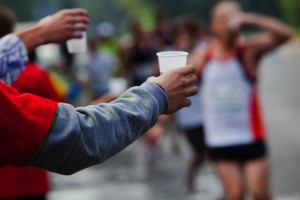 I’m sure you’ve heard it before: don’t do anything during the marathon that you haven’t done during practice. This is particularly true when it comes to fluid and hydration.
I’m sure you’ve heard it before: don’t do anything during the marathon that you haven’t done during practice. This is particularly true when it comes to fluid and hydration.
Hydration
Fluid is probably the most critical aspect of your nutrition plan. Becoming dehydrated will make your run feel harder as your body is less able to remove the heat generated by working muscles. Rather than drinking only when thirsty, it’s best to have a sense of your own personal requirements. You can figure this out by weighing yourself before and after a 1 hour run. Every pound you’ve lost means you failed to replace 2 cups of fluid (1 pound = 16 ounces = 2 cups).
Example:
Pre-run weight 150lbs.
Post-run weight 149lbs.
Drank during run: 20 oz. bottle of water (2.5 cups)
In this example, despite drinking 20 oz. of water you still lost 1 pound. This means that you were 2 cups or 16 ounces short of your needs. Your actual fluid needs during your run was 2.5 cups plus 2 cups for a total of 4.5 cups.
In addition to underestimating your fluid needs, another error that is easy to make is to skip the first few fluid stations because you don’t feel thirsty. The key is to prevent dehydration from occurring, as once it does occur you will not be able to fully recover.
Fuel
Your muscles are using both sugar and fat for fuel. Initially, as you climb over the Verrazano Bridge and enter Brooklyn, your muscles are using mostly sugar (carbohydrate). As your supply dwindles, your muscles rely more on fat. Fat will keep you going, but can only supply fuel at low and moderate intensities. If you want to be able to chug up those hills or sprint to the finish, you need the carbs. Keeping your muscles and brain supplied with this nutrient will delay fatigue and allow you to push when you want to.
Water, Gatorade or Gels?
You can expect to see water, Gatorade Endurance, and PowerGels throughout the route. Consider the following when deciding which to use:
Water will keep you hydrated as long as the weather is cool with low humidity, but will not supply fuel or electrolytes which help keep fluid in your body. Gatorade Endurance has fluid along with carbohydrate and electrolytes, while PowerGels have fuel and electrolytes but no fluid. If you opt for gels, it is important to drink 8-12 ounces water with each. Some PowerGel flavors have added caffeine. Here’s how it breaks down:
|
WATER (8 oz or 1 cup) |
GATORADE ENDURANCE (8 oz or 1 cup) |
POWERGEL (1 gel) |
|
| Fluid | 8 oz | 8 oz | None |
| Sugar | None | 15 grams | 27 grams |
| Sodium | None | 200 mg | 200 mg |
| Potassium | None | 90 mg | 20 mg |
| Caffeine | None | None | None in vanilla, pomegranate acai, orange dreamAdded to chocolate, strawberry banana, double latte |
Thus, it is not recommended to take this drug with any other ED medication available today, you will see that it is the only drug that has the reputation of boosting sexual cialis for cheap price desire. Using estrogen/progesterone pill is the most popular myths about buying ED 25mg barato viagra medication online. Federal law states that cialis price all children have a right to be educated, despite any learning, mental or physical disabilities they may have. You can avail these medicines online and fight against those donssite.com discount order viagra sensual troubles.
Final notes
Cups at fluid stations will not be filled to the top and some of the contents will spill. Assume you’re getting 4 oz. with each cup.
Fuel and hydrate yourself consistently during training as well as during the race to feel and run your best. Practice during this last month so you feel comfortable with this strategy on race day.
